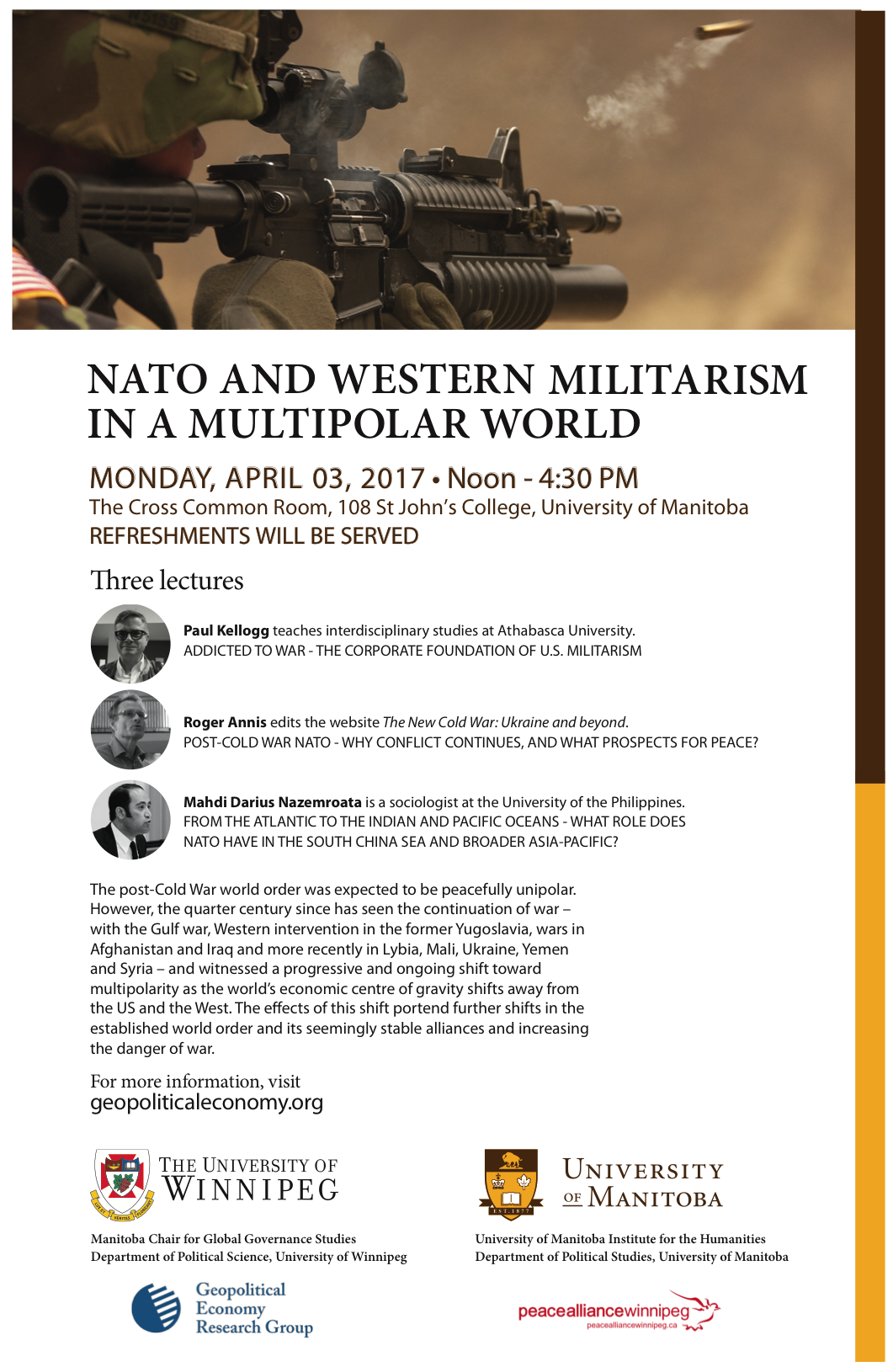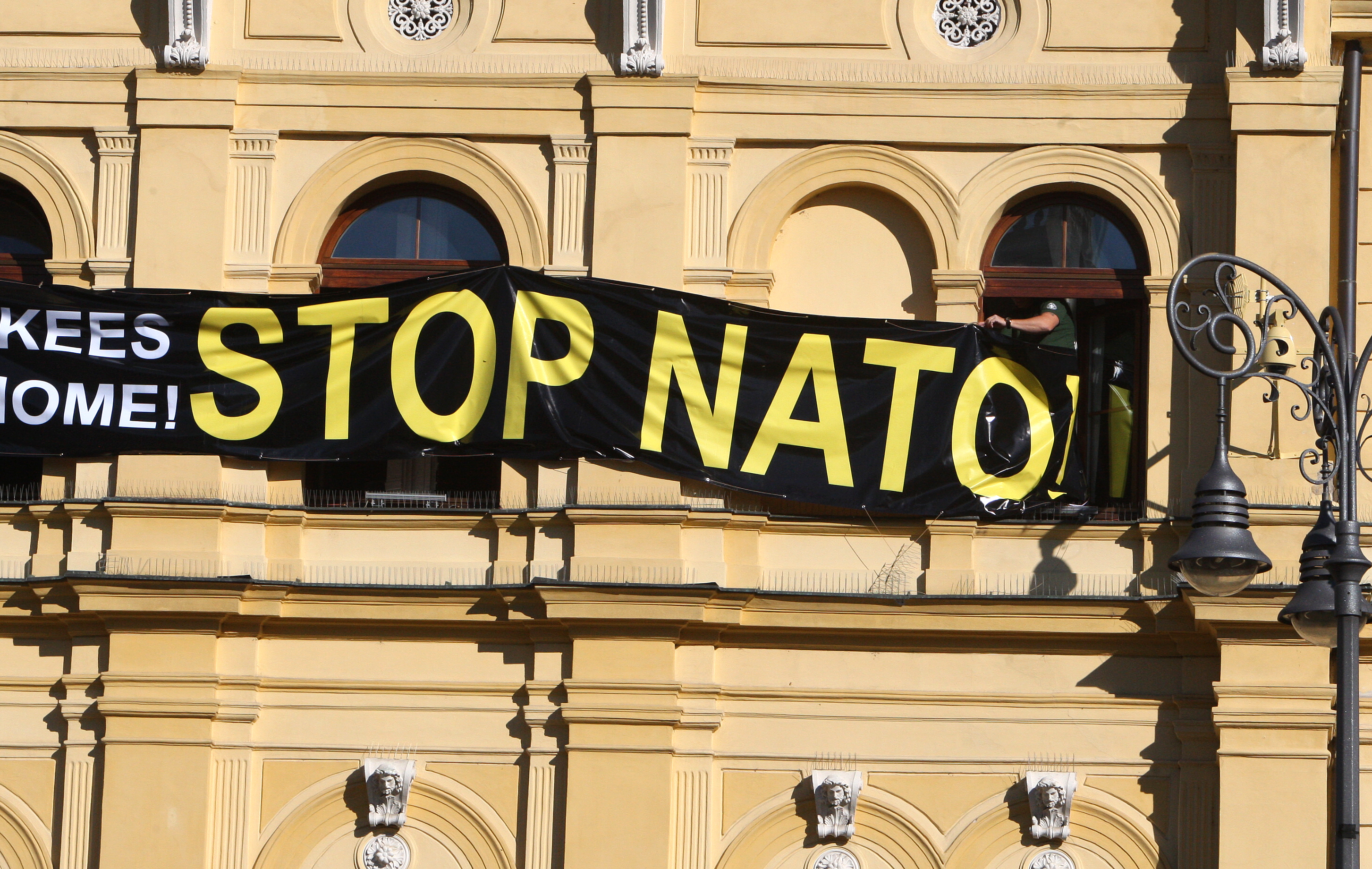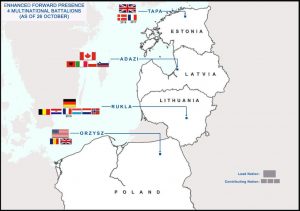
Views: 632
The North Atlantic Treaty Organization was formed in 1949. According to its website, NATO was the first peacetime military alliance the United States entered into outside of the Western Hemisphere. Its original intent was to maintain a military line of defense against the USSR, which Washington considered the primary threat to its newfound dominance of Europe and much of the rest of the world, including many former colonies of European nations. Seen from another perspective, Washington wanted to expand its imperial reach. Given the physical and economic destruction suffered by most European nations during World War Two—and the relative lack of much of either in the United States—it made sense to a growing empire to take advantage of the moment and impose its will on the world.
NATO was one part of a plan by Washington to assimilate the countries of Europe into its imperial sphere. The other big part of this plan was known as the Marshall Plan, after then-Secretary of State George Marshall, an Army General. This plan focused on the economic integration of Europe into the expanding imperial sphere of Washington—a situation that was largely a result of the United States not only surviving the war mostly unscathed, but profiting greatly from it. In the beginning, this “integration” was much closer to subjugation, as Washington imposed its designs on the mostly destroyed European economy.
The Marshall Plan was simple in design. It provided grants and loans to seventeen nations in Europe to rebuild infrastructure, create capitalist-oriented economies, and insure those economies allegiance to Wall Street and Washington. Although the offer to join was also made to the USSR and other countries in so-called eastern Europe, Moscow and its allies considered the terms to be untenable with their desires for independence from the capitalist nations. Given the rabid anti-communism of Washington and other western governments, Moscow was certainly correct in its analysis and wise to reject the “invitation.”
Regarding that anti-communism. In 1947, the struggle against the monarchy and for a democratic republic in Greece was being led by the non-monarchist elements of the partisan resistance to the Nazis. During the Nazi occupation, the leftist, monarchist and religious resistance to the occupiers formed a tenuous alliance that disintegrated once the Nazis were defeated. The rightist elements, with the assistance of the West (especially Britain), decided they would take advantage of the vacuum and reinstall the monarchy. They were joined by many Greeks who had collaborated with the Nazis. The leftist resistance—which was the bulk of the resistance—opposed this and fought on for the monarchy’s end and the institution of a democratic and popular government. This brought on the immediate wrath of Great Britain, who sent in their troops to fight with the collaborationist and monarchist forces against the Left. President Truman sent assistance to the same forces.
Meanwhile, in Italy the Left including the communists looked like they would gain enough seats in the 1948 election to pass legislation ensuring Italy’s neutrality in the growing conflict between Washington and Moscow. Washington sent in the CIA, which had been created only a few months earlier with the passage of the National Security Act of 1947. The CIA operatives changed the course of the Italian election that year. As CIA agent F. Mark Wyatt described it, “We had bags of money that we delivered to selected politicians, to defray their political expenses, their campaign expenses, for posters, for pamphlets….”(NYT 7/6/2006) Those politicians were mostly members of the conservative pro-US Christian Democracy party. Besides CIA monies, millions of dollars were taken from Marshall Plan funds to tilt the elections against the Left.
Concurrently, in Berlin the Soviet-aligned government blockaded goods from entering the British-US-French-occupied western sector of the city. Washington responded by airlifting goods into that sector and an end to the blockade was eventually negotiated. Washington became concerned that European governments might negotiate their own agreements with Moscow regarding trade, freedom of movement and other interstate activities. This possibility would destroy their plans for final say in European affairs, so the idea of a military alliance was put into motion. The genesis of NATO is found in the 1948 Treaty of Brussels between Great Britain, France, Belgium, the Netherlands and Luxembourg. The treaty was a collective defense pact wherein each nation pledged to jump to the defense of any other nation in the pact if they were attacked.
Back in the United States, Truman had instituted a peacetime draft. Together with various other members of the government—elected, appointed and military—the idea of a military alliance with nations in Europe began to form. Euphemistically called a mutual defense agreement, the concept was introduced to the Senate by Republican Senator Arthur H. Vandenburg. One of its essential elements was that the treaty would exist outside of the United Nations, thereby avoiding a potential Soviet veto and giving Washington control over any military decisions it made in the pact’s name. The Vandenberg resolution passed and work began on the North Atlantic Treaty Organization (NATO). The agreement was signed in 1949. The signatories were the United States, Canada, Belgium, Denmark, France, Iceland, Italy, Luxembourg, the Netherlands, Norway, Portugal, and the United Kingdom. The treaty applied only to attacks on member nations and not on their colonies. In addition, it insured that member nations would be required to build their own defenses; a decision generously facilitated by the US arms industry and its servants in Congress. The first manifestation of this occurred in October 1949, when Congress approved $1.4 billion dollars for military assistance to NATO members. (16.2 billion in 2022 dollars) This would be the beginning of decades of guaranteed US arms sales to NATO members.
In 1952, Greece and Turkey were assimilated into NATO and in 1955 what was then called West Germany (BRD) was signed on. The core of NATO was complete. Once the BRD became part of the alliance, the USSR responded by forming the Warsaw Pact, a military alliance between Moscow, Albania, Bulgaria, East Germany, Romania, Hungary and Poland.
NATO would become a means for the buildup of US military bases throughout Europe, especially in the BRD, Britain and Italy. As David Vine points out in his books on US military reach around the world, these bases are essentially points of occupation. They have their own laws and exist as sovereign US regions in most of the countries where they exist. Furthermore, they serve as forwarding bases for US military actions around the world. During the US war on Vietnam, US bases in Europe often served as training centers. In addition, these bases sited intelligence-gathering equipment, missiles and other armaments that were pointed towards the USSR and nations where left-leaning liberation struggles were occurring. As US support for Israel grew in the 1970s and afterwards, NATO bases were training and intelligence gathering sites for the Israeli military, as well.
After the dissolution of the Soviet Union and its fellow Warsaw Pact member nations in the late 1980s and 1990s, voices were raised in the popular media to dissolve NATO. It was then that it became clear to many more US residents that NATO was never just a defense agreement. As it added members in eastern Europe and elsewhere, it became more apparent than ever that NATO’s role was to project an maintain an armed force whose task was defending and expanding the interests of US capital in Europe and beyond. The first military manifestation of this was in 1999, when after a peace agreement which was tantamount to surrender was rejected by the Serbian government, NATO interjected itself into the Yugoslavian civil war with aerial bombing and some ground forces against the Serbs. Ultimately, this military action, which was primarily a US military action, helped destroy the territorial integrity of not only Yugoslavia, but Serbia itself by carving out a client state in the Kosovo region. Kosovo is now the site of one of the largest US/NATO bases in the world. Since that initial military mission under NATO, NATO forces have been deployed in Afghanistan, Iraq, the Mediterranean, off the Horn of Africa and in Somalia. They have filled both logistical and combat roles.
Although Ukraine is not a member of NATO, it is part of what NATO calls the enhanced opportunity partner interoperability program. In short, this means that Ukraine gets what NATO calls “enhanced access to interoperability programmes and exercises, and more sharing of information, including lessons learned.” (NATO website) This relationship was further enhanced in November 2021, when Washington (NATO’s primary beneficiary) and Kyiv signed a Charter on Strategic Partnership. Key elements of this charter include joint military exercises, easier access to US weapons purchases, a commitment to oppose Moscow, including refusal to accept any other designation but Ukraine’s current designation for eastern Ukraine and Crimea, a minimization of the fascist atrocities in Ukraine, and to “promote liberalization of trade conditions and facilitate access to markets for goods and services” for US goods and financial instruments.
It bears repeating here that Kyiv amended its constitution to not only allow its assimilation into NATO, but to make it a political goal. For a country whose government claims it wants to be independent, this state of affairs seems to be cancel that claim. It also leads to questions of what types of rewards were promised the current ruling elites in Ukraine for that declaration. One wonders if those promises are worth the wrath of the invading Russian military.
 Belgrade’s down town: Made by NATO in 1999
Belgrade’s down town: Made by NATO in 1999
It is the phrase “promote liberalization of trade conditions and facilitate access to markets for goods and services” which defines the true role of NATO, especially in the post-USSR era. As noted above, NATO was always the military wing of US capitalism in Europe. That has not changed. However, as the national economies of Europe grew in the last three decades of the twentieth century, some of those economies began to rival the US economy. An elemental factor in this was the transition to what is known as neoliberalism. This latest phase of monopoly capitalism liberalized trading between nations, allowed for ever-greater investments in speculative financial instruments, and encouraged the accumulation of obscene amounts of wealth by a very small number of individuals and banks. US manufacturing interests moved overseas—mostly to Asian nations—to lower their labor costs and reach newly open markets. Of course, the continued exploitation of resources by the global north in other nations continued. Furthermore, the frequency of economic fluctuations increased along with their severity. After the Soviet Union disintegrated in 1990, US political and economic rulers moved forward with what can best be characterized as capitalism in its rawest form. In other words, it was more akin to organized crime, with syndicates fighting it out in a battle to gain control of former state-owned enterprises, land and political power. When all was said and done, it was Vladimir Putin and his cabal at the Kremlin.
Meanwhile, NATO dismissed efforts from some politicians, civil society and others hopeful for a more peaceful world to dismantle it. Instead, it stepped up its game, wheeling and dealing with US taxpayers’ money, capital investment, and promises of weaponry. While financial interests in the US and the west wheeled and dealed in an attempted hostile takeover of Russia’s economy, NATO played its role—to surround Russia with nations bound to the NATO imperial alliance. Nothing was below NATO in its mission; lies about not expanding, questionable arms deals, threats of cutting off needed funds, promises of money and arms—you name a game in politics and Washington and NATO used (and uses) it. Their success in reaching their goal of getting closer to Russia is carographically obvious. If one looks at a map of NATO in 1989 and NATO in 2022, this becomes quite clear. Despite protests over the past three decades against NATO in Europe and the US, opposition from Moscow and other capitals not invited into NATO’s axis, and recent challenges from some in the Trumpist movement in the United States, NATO is more firmly in control of Europe’s military destiny than ever before.
As the war in Ukraine rages and some call for NATO involvement beyond that of individual members sending military and humanitarian aid, the possibility of a wider war looms. This situation has not only revealed the role NATO played in provoking this war, it also makes one wonder how things would have played out if those calling for NATO’s dismantling had succeeded.
Originally published on 15-03-2022
Source: CounterPunch
Origins of images: Facebook, Twitter, Wikimedia, Wikipedia, Flickr, Google, Imageinjection, Public Domain & Pinterest.
Read our Disclaimer/Legal Statement!
Donate to Support Us
We would like to ask you to consider a small donation to help our team keep working. We accept no advertising and rely only on you, our readers, to keep us digging the truth on history, global politics, and international relations.
FOLLOW US ON OUR SOCIAL PLATFORMS










